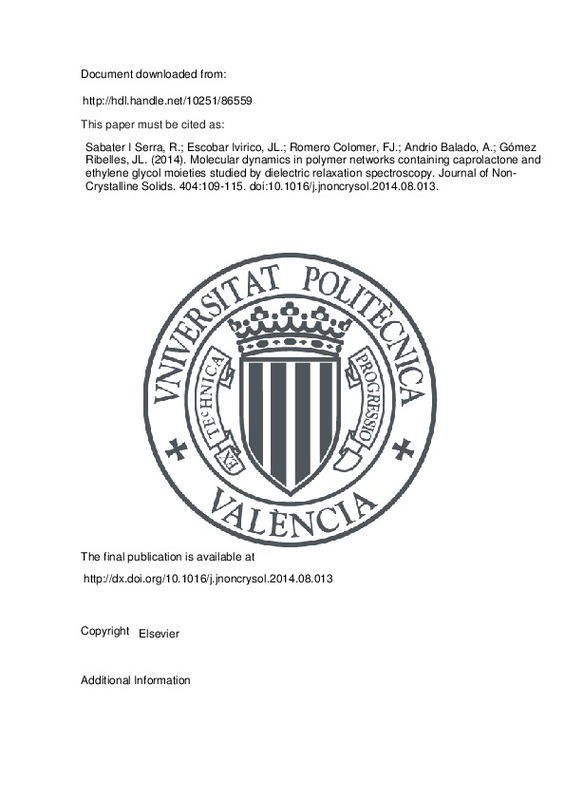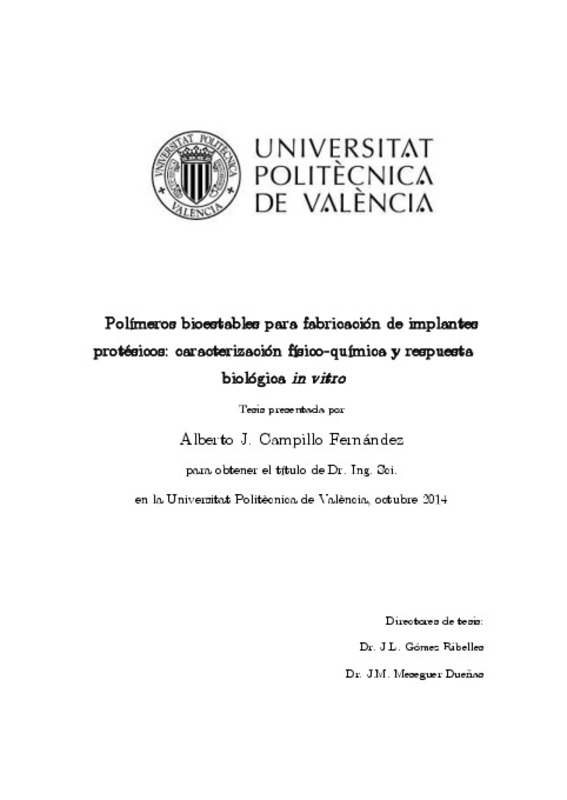

Listar por palabra clave "Copolymer networks"
RiuNet: Repositorio Institucional de la Universidad Politécnica de Valencia
- RiuNet repositorio UPV
- :
- Listar por palabra clave
JavaScript is disabled for your browser. Some features of this site may not work without it.
Buscar en RiuNet
Listar
Mi cuenta
Ayuda RiuNet
Admin. UPV
Listar por palabra clave "Copolymer networks"
Mostrando ítems 1-6 de 6
-
Escobar Ivirico, Jorge Luis; Salmerón Sánchez, Manuel; Gómez Ribelles, José Luís; Monleón Pradas, Manuel (Wiley, 2011)New biodegradable block copolymer networks were synthesized from methacrylate-terminated poly(L-lactide) (mLA) and polycaprolactone (mCL) macromers. This allowed the realization of a series of materials in which the macromer ...
-
Sabater i Serra, Roser; Escobar Ivirico, Jorge Luis; Romero Colomer, Francisco José; Andrio Balado, A.; Gómez Ribelles, José Luís (Elsevier, 2014-11-15)Copolymer networks with methacrylate main chain and caprolactone and ethylene glycol side groups were obtained by free radical copolymerisation of caprolactone methacrylate (CLMA) and poly(ethylene glycol) methacrylate ...
-
Sabater i Serra, Roser; Kyritsis, A.; Escobar Ivirico, J.L.; Gómez Ribelles, José Luís; Pissis, P.; Salmerón Sánchez, Manuel (SPRINGER, 2011)[EN] Poly( ε -caprolactone)/poly(hydroxyethyl acrylate) networks have been investigated by thermally stimulated depolarization currents (TSDC) and differential scanning calorimetry (DSC). The introduction of hydrophilic ...
-
Campillo Fernández, Alberto José (Universitat Politècnica de València, 2014-11-17)La necesidad de polímeros bioestables para fabricación de implantes protésicos queda patente, entre otros indicadores, por la proliferación de dispositivos actualmente comercializados. La caracterización físico-química ...
-
Perez Garnes, Manuel; Monleón Pradas, Manuel (Elsevier, 2017)[EN] Semi-biodegradable copolymer networks derived from two immiscible components, a hyaluronan derivative (methacrylated hyaluronan) and poly(ethyl acrylate), have been developed for soft tissue engineering applications. ...
-
Escobar Ivirico, Jorge Luis; García Cruz, Dunia Mercedes; Araque Monrós, María Carmen; Martínez Ramos, Cristina; Monleón Pradas, Manuel (Springer Verlag (Germany), 2012-07)Copolymer networks from poly(ethylene glycol) methacrylate (PEGMA) and caprolactone 2-(methacryloyloxy) ethyl ester were synthesized and the resulting structure of the copolymer network was characterized by differential ...
Mostrando ítems 1-6 de 6

Universitat Politècnica de València. Unidad de Documentación Científica de la Biblioteca (+34) 96 387 70 85 · RiuNet@bib.upv.es





